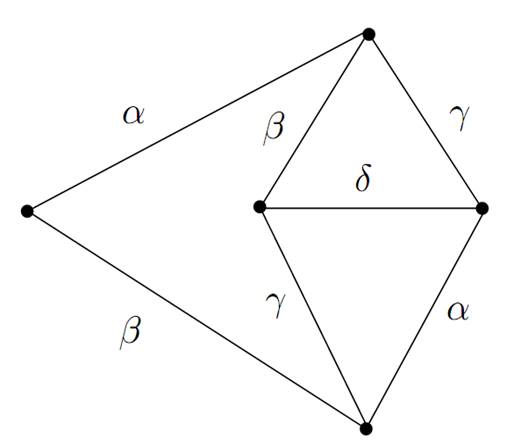
Coloring-Edge coloring
 المؤلف:
Jean-Claude Fournier
المؤلف:
Jean-Claude Fournier
 المصدر:
Graph Theory and Applications
المصدر:
Graph Theory and Applications
 الجزء والصفحة:
65
الجزء والصفحة:
65
 27-7-2016
27-7-2016
 2130
2130
The graphs studied are assumed to be without loops but may have multiple edges. The “simple” hypothesis thus will mean that the graph is without multiple edges. Given a graph G and an integer k, k-edge-coloring of G is a mapping from the set of the edges of G to a set of k elements called

Figure 1.1. A k-edge-coloring of a graph (set of colors: {α, β, γ, δ})
colors so that two edges sharing an endpoint are associated in the mapping with different colors.
Given a k-coloring, an edge is said to be of a given color or to have a given color, if in the coloring considered this color is associated with it.
The edge chromatic number of a graph G is the lowest integer k such that a k-coloring of G exists. This integer is denoted by q(G). For example, the chromatic index of the graph shown in Figure1.1 is 4 (check that for this graph there is no edge coloring with less than four colors). The important point of the concept of edge-coloring of a graph is the following property: for each color, the set of the edges having the same color forms what is called a matching, that is a set of edges of the graph such that no two edges share a common endpoint. A k-edge-coloring of a graph G can be seen, more or less a permutation of the colors, as an edge partition of G into matchings. The chromatic index is then the lowest number of classes of such a partition.
This point of view will become useful later.
Graph Theory and Applications ,Jean-Claude Fournier, WILEY, page(65)
 الاكثر قراءة في نظرية البيان
الاكثر قراءة في نظرية البيان
 اخر الاخبار
اخر الاخبار
اخبار العتبة العباسية المقدسة


